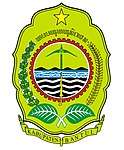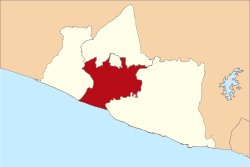Bantul Regency
Bantul (Indonesian pronunciation: [ˈbantʊl]) is a regency located in the Yogyakarta Special Region, Indonesia. It is located on the island of Java. The regency's population was 911,503 at the 2010 Census, but has risen to 947,568 according to the latest (January 2014) official estimate. Like many regencies on the island of Java, it is densely populated with roughly 1,865 people per square kilometre, although this is largely because the north of the regency partly surrounds the city of Yogyakarta and contains many suburban communities.
Bantul Regency Kabupaten Bantul | |
|---|---|
 Seal | |
| Motto(s): Projotamansari | |
 Bantul Regency in Special Administrative Region of Yogyakarta | |
| Coordinates: 07°44′04″S 110°12′34″E | |
| Country | Indonesia |
| Special Administrative Region | Yogyakarta |
| Capital | Bantul |
| Government | |
| • Regent | Suharsono |
| Area | |
| • Total | 508.13 km2 (196.19 sq mi) |
| Population (2014) | |
| • Total | 947,568 |
| • Density | 1,900/km2 (4,800/sq mi) |
| Time zone | UTC+7 (WIB) |
| Post Code | 55000 |
| Area code(s) | 0274 |
| Website | bantulkab.go.id |
The regency is bordered by the city of Yogyakarta and Sleman regency to the north, the regency of Kulon Progo to the west, the Gunung Kidul Regency to the east and the Indian Ocean to the south. The town of Bantul is the administrative centre.
The village Kemusuk in the Sedayu district in the regency is the birthplace of former Indonesian President, Suharto.
2006 earthquake
On 27 May 2006 an earthquake measuring 6.3 on the Richter scale struck near Java's southern coast causing widespread damage. Bantul Regency was the region most affected by the disaster. Around 4,100 residents of Bantul Regency were killed, 12,000 were injured. 72,000 houses were destroyed, and 137,000 were damaged.[1]
Administrative districts
Bantul Regency is divided into 17 districts (kecamatan), listed below with their populations at the 2010 Census:[2]
|
|
|
Turtles nesting
Bantul Regency has 2 locations of turtles nesting, in Gua Cemara Beach and Pelangi Beach. Both have only more than 10 nests each in a year. Nesting period is in July and August.[3]
References
- Budy P. Resosudarmo; Catur Sugiyanto; Ari Kuncoro (October 2008). "Livelihood Recovery after Natural Disasters and the Role of Aid: The Case of the 2006 Yogyakarta Earthquake" (PDF). Australian National University. Retrieved 4 March 2012.
- Biro Pusat Statistik, Jakarta, 2011.
- "Penyu Laut Mulai Bertelur di Pantai Selatan Yogyakarta". July 4, 2015.